23rd Annual Railcar Convention
Epping & Ongar Railway, 5th-7th October 2018.
Report by Chris Moxon
Introduction
 The 2018 Convention saw The Railcar Association return to the county of Essex for the first time in ten years, the last time being in 2008 when the Colne Valley and East Anglian Railway Museum joint hosted. It was also surprisingly only the third time that the convention had been hosted in an area previously considered part of British Railways' Eastern Region. The venue was the Epping Ongar Railway which pleasingly was hosting for the first time, it is always interesting having a convention at a "new" railway.
The 2018 Convention saw The Railcar Association return to the county of Essex for the first time in ten years, the last time being in 2008 when the Colne Valley and East Anglian Railway Museum joint hosted. It was also surprisingly only the third time that the convention had been hosted in an area previously considered part of British Railways' Eastern Region. The venue was the Epping Ongar Railway which pleasingly was hosting for the first time, it is always interesting having a convention at a "new" railway.
In contrast to the previous year's gala extravaganza format, the event was much more in line with a "normal" convention, with the home based Class 117/121 hybrid 2-car set supplemented by visiting Class 121 W55033 from the neighbouring Colne Valley, which was able to visit as it coincided with a brief road trip to the Ilford wheel lathe for contract tyre turning. The proximity to the Great Eastern commuter lines radiating from London Liverpool Street, plus the resident and visiting stock gave the convention a decidedly suburban theme which hadn't been experienced since the Gloucestershire Warwickshire convention five years previously.
Friday
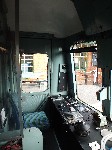 The Friday was firmly set in tradition as Driver Experience day, with Class 117/121 hybrid 2-car power/trailer 51384/56287 in use for delegates throughout the day. It shuttled intensively between Ongar, through North Weald to Epping Forest, where the boundary between preservation and the London Underground exists. This latter feature was one of the unique aspects of this line. The approach to the boundary is via increasingly steep gradients starting at 1in149, then 1in70 and finally 1in56 before reaching the stop board! Of course such high risk conditions means that traditional driver experiences must stop short of this downward "ski slope", however certain trips which were being run by passed drivers from other railways were able to include this final section "to the stops".
The Friday was firmly set in tradition as Driver Experience day, with Class 117/121 hybrid 2-car power/trailer 51384/56287 in use for delegates throughout the day. It shuttled intensively between Ongar, through North Weald to Epping Forest, where the boundary between preservation and the London Underground exists. This latter feature was one of the unique aspects of this line. The approach to the boundary is via increasingly steep gradients starting at 1in149, then 1in70 and finally 1in56 before reaching the stop board! Of course such high risk conditions means that traditional driver experiences must stop short of this downward "ski slope", however certain trips which were being run by passed drivers from other railways were able to include this final section "to the stops".
In total six round trips were operated before the 117/121 set was swapped for the visiting Class 121 which proceeded to do several more trips allowing further experiences to be run as well as combining with some of the owning group who were able to enjoy driving their unit on a foreign railway.
 The experiences themselves were most enjoyable with drivers really having to work the unit hard. With both vehicles being of the heavier "long" type a single vehicle carrying a trailer around up and down proved a challenge when tackling most of the line which is around 1in70 for most of its length. The gradient profile for the line resembles a letter M and the vehicles were constantly powering hard or rolling downward requiring keen driver attention. The first trip terminated at Epping Forest and encountered poor railhead conditions on its return leading to a delay as sand was applied and the underpowered unit slowly crawled up the 1in56. Luckily once the unit had passed over the rails a few times normal running proceeded for the rest of the day. It was a great pleasure being able to drive over such interesting track.
The experiences themselves were most enjoyable with drivers really having to work the unit hard. With both vehicles being of the heavier "long" type a single vehicle carrying a trailer around up and down proved a challenge when tackling most of the line which is around 1in70 for most of its length. The gradient profile for the line resembles a letter M and the vehicles were constantly powering hard or rolling downward requiring keen driver attention. The first trip terminated at Epping Forest and encountered poor railhead conditions on its return leading to a delay as sand was applied and the underpowered unit slowly crawled up the 1in56. Luckily once the unit had passed over the rails a few times normal running proceeded for the rest of the day. It was a great pleasure being able to drive over such interesting track.
A few photographic stops were able to be made during the day and some good use made of the sun which was out in force. Instructors were very friendly and various facts about the line and surrounding areas were discussed.
Saturday
Saturday saw the event open to the public. The railway was running a steam service as normal so as not to disappoint the average visitor and also for additional variety. The locomotive in use was Metropolitan No1, most appropriate for a railway associated with the London Underground, albeit the Central Line. No1 ran three trips between North Weald and Ongar, as the Epping Forest section is limited to trains either top & tailed or railcar operated. Slotting in between No1 on the Ongar section, and having free reign over the Epping end, was the Class 117/121 and the visiting 121 "bubble car" W55033.
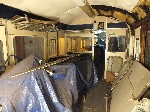 A trip or two was possible before a mid morning guided tour of the locomotive restoration sheds at North Weald. During this tour we encountered the final DMU vehicle on site at the railway, Class 117 DMBS 51342. This is the true partner to the Class 117 in service (51384) but its extended restoration led to Class 121 trailer 56287 being hired in to allow 51384 to enter service as a complete set. The interior restoration of 51342 had already been completed before a small corroded area led to huge further problems with the vehicle's cant rails being discovered. This meant the state of affairs when we inspected 51342 was that of serious bodywork repairs to the secondman's side, with more on the opposite side planned. Ideas and experiences were exchanged whilst the remainder of the party explored the adjacent steam and diesel fleets under repair and restoration.
A trip or two was possible before a mid morning guided tour of the locomotive restoration sheds at North Weald. During this tour we encountered the final DMU vehicle on site at the railway, Class 117 DMBS 51342. This is the true partner to the Class 117 in service (51384) but its extended restoration led to Class 121 trailer 56287 being hired in to allow 51384 to enter service as a complete set. The interior restoration of 51342 had already been completed before a small corroded area led to huge further problems with the vehicle's cant rails being discovered. This meant the state of affairs when we inspected 51342 was that of serious bodywork repairs to the secondman's side, with more on the opposite side planned. Ideas and experiences were exchanged whilst the remainder of the party explored the adjacent steam and diesel fleets under repair and restoration.
Following the tour delegates either had another small ride or in most cases, retired for lunch in the railway's Anglia buffet coach. It's funny how places providing food can be the place to be, especially during poor weather which sadly made itself known during the day, in stark contrast to the beautiful conditions present on the Friday. All too soon 2 o'clock arrived which marked the start of the general meeting.
Formal Meeting
 Finding a suitable local venue for the meeting proved far more difficult this year than is ordinarily the case. Things were looking bleak before the Epping Ongar Railway rescued us with the use of their marquee at North Weald, which whilst unheated, provided the space we needed to allow the meeting to happen. We are in debt to them for this as well as providing the necessary tables, chairs and space heater borrowed from the workshops!
Finding a suitable local venue for the meeting proved far more difficult this year than is ordinarily the case. Things were looking bleak before the Epping Ongar Railway rescued us with the use of their marquee at North Weald, which whilst unheated, provided the space we needed to allow the meeting to happen. We are in debt to them for this as well as providing the necessary tables, chairs and space heater borrowed from the workshops!
30 delegates attended the meeting which was a nice middle-of-the-road figure if comparing with previous years. The meeting started with the normal Chairman's address with a brief summary of the railcar matters for the year. Apologies were received and included Ian Bradbury, Chris Bull, Gareth Coleman, Trevor Daw, Kevin Dowd, Jim Poor and the members of the Swindon Diesel Preservation Society based at Bo'ness.
The question was raised by the Chairman as to what the cut-off point for railcars within the association should be. Whilst it was felt that cutting off at a certain point may in the future lead to new members not being interested in joining as we did not cater for "their traction", different technologies and practicalities meant that it was felt there needed to be a limit so as not to be overstretched in terms of support and expertise. It was decided that any decision could always be reviewed in the future, but for now a limit would be set within the BR era, so only stock built before 1996 would be recognised by the association.
The Chairman also nominated a prominent member of the Railcar community to be the Association's first Honorary President which was immediately seconded by Brian Smith. A vote was taken and the choice was unanimously in favour.
The first presentation was Chris Moxon's summary of the year for the preserved vehicles. There were no new additions to the fleet but three Class 141 vehicles were scrapped. Seven vehicles were identified as "at risk" of scrapping in the next 12 months but none of them were historically vital. There had been a lot of road movements this year with 10 vehicles moving permanently to new homes and a record 7 vehicles moving for gala events or hire contracts. A list of restorations and overhauls that had both been started and been completed was then explained before some number crunching. Total DMU's preserved had dropped from 280 to 277. The operational DMU fleet had dropped from 150 to 144 whilst the number of active restorations was fairly stable, changing from 46 to 45. Generally more classes of railcars had decreased in availability than increased, the exception being the Class 119's which have done well this year.
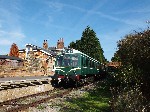 The next presentation was by Martin Smith of Pressed Steel Heritage, who had two vehicles present at this year's event. Martin explained how the group was formed, its original aims and how these differed to what the group ended actually up with! They are now the proud owners of an authentic Class 121 bubble car and trailer pairing, although the two exact vehicles preserved did not run together. It was explained how the fleet was originally built up, with 56287 (121 DTS) being the first vehicle moved to Mangapps Farm. A powercar, 51347 (117 DMBS) was bought to run with 56287 but this arrangement was not satisfactory at Mangapps so 51347 was moved to the Colne Valley shortly after and 56287 sold. A new partner was acquired for 51347 at Colne, 51138 (116 DMBS), as well as a spares donor in the form of 51151 (116 DMS). It was at this point that the bubble car 55033 joined the collection, this one costing a premium of £3,00 when other vehicles at the time were £1,000! Vehicles continued to arrive with 51401 (117 DMS) being sent to the Nene Valley Railway on hire with 51347 to form a set, with the now partner-less 51138 pairing up with spares donor 51151 to form a proper Class 116 set. At this point it was realised there were too many vehicles in the fleet to cope with, so the 116 set was sold to the Great Central North and the 117 to the Nene Valley, leaving just the bubble car 55033. The group then however wanted their first vehicle 56287 back to form a proper 121 pairing. 56287 at Mangapps required a repaint by this time, so agreement was reached for it to be swapped with another vehicle if the replacement vehicle was freshly painted. Class 117 DMS 51381 was duly sourced and swapped for 56287 which was able to join 55033 at the Colne Valley. Since then (2004) the collection has remained stable and the main challenges have been completing restoration work with the limited facilities available. More recently, 56287 was not being used much so was hired to the Epping Ongar Railway who required a vehicle to run with half of their 117 set whilst the other half received restoration work. This brought the story up to the present day, and with more work including a repaint to the bubble car, it's looking like Pressed Steel Heritage have enough to be getting on with for some time!
The next presentation was by Martin Smith of Pressed Steel Heritage, who had two vehicles present at this year's event. Martin explained how the group was formed, its original aims and how these differed to what the group ended actually up with! They are now the proud owners of an authentic Class 121 bubble car and trailer pairing, although the two exact vehicles preserved did not run together. It was explained how the fleet was originally built up, with 56287 (121 DTS) being the first vehicle moved to Mangapps Farm. A powercar, 51347 (117 DMBS) was bought to run with 56287 but this arrangement was not satisfactory at Mangapps so 51347 was moved to the Colne Valley shortly after and 56287 sold. A new partner was acquired for 51347 at Colne, 51138 (116 DMBS), as well as a spares donor in the form of 51151 (116 DMS). It was at this point that the bubble car 55033 joined the collection, this one costing a premium of £3,00 when other vehicles at the time were £1,000! Vehicles continued to arrive with 51401 (117 DMS) being sent to the Nene Valley Railway on hire with 51347 to form a set, with the now partner-less 51138 pairing up with spares donor 51151 to form a proper Class 116 set. At this point it was realised there were too many vehicles in the fleet to cope with, so the 116 set was sold to the Great Central North and the 117 to the Nene Valley, leaving just the bubble car 55033. The group then however wanted their first vehicle 56287 back to form a proper 121 pairing. 56287 at Mangapps required a repaint by this time, so agreement was reached for it to be swapped with another vehicle if the replacement vehicle was freshly painted. Class 117 DMS 51381 was duly sourced and swapped for 56287 which was able to join 55033 at the Colne Valley. Since then (2004) the collection has remained stable and the main challenges have been completing restoration work with the limited facilities available. More recently, 56287 was not being used much so was hired to the Epping Ongar Railway who required a vehicle to run with half of their 117 set whilst the other half received restoration work. This brought the story up to the present day, and with more work including a repaint to the bubble car, it's looking like Pressed Steel Heritage have enough to be getting on with for some time!
The following two presentations were by Evan Green-Hughes with the first being an update on the last of the "Holy Grail" DMU sets to remain at risk of loss. For those who weren't aware of the "Holy Grail", the term is used amongst the railcar fraternity for an exclusive collection of extremely rare first generation DMU's which are the last surviving sets of their class/type. A scrapping of any of the Holy Grail sets would be considered by the community as a huge historical loss and should be avoided at all cost. The Holy Grail sets include the Derby Lightweight (Ecclesbourne Valley), Gloucester 100 (Llangollen Railcars), Park Royal 103 (Helston), Cravens 105 (East Lancs), Wickham 109 (Llangollen Railcars), Gloucester 119 (Swindon & Cricklade) and Swindon 126 (Bo'ness & Kinneil). All of the above over the past 25 years have changed ownership and slowly been moved into secure hands and are either restored to running condition or under restoration to similar standards, with the exception of the Park Royal 103 which is currently deteriorating with no realistic funding or facilities to reverse the situation. The current owners appear to be unfamiliar with how DMU preservation works i.e. unrestored vehicles are normally worth no more than their own scrap value (regardless of their rarity) whilst running sets command the higher prices when sold. This fact proves a sticking point to a degree as it would be hard enough re-homing a unit which requires a full rebuild without adding a large purchase cost. Evan had been down this year to complete a condition assessment and was well placed to do so having been heavily involved in two Holy Grail sets already (109 & 100). Initially in pictures on the internet the unit doesn't look too bad, however up close the tell-tale signs of severe structural corrosion is apparent. The unit obviously hasn't operated for many years and despite being advised it is complete there are a few major components missing. However luckily most of the missing mechanical components are very standard items (such as vacuum cylinders) which would prove no problem to any of the established groups to replace. The set has several modifications, the most amusing being a large central heating boiler fitted to the outside of the trailer car! Underneath the vehicle is reportedly quite nasty with corrosion evident, probably from its days near the sea front at Minehead. There was a suggestion that asbestos "may" be present, although not proven on this occasion. The rear passenger saloon of the trailer is now a buffet and the guards van a kitchen. Evidence of roof leaks is present. The final consensus was that the set was by no means beyond redemption, as it is broadly complete and in better condition than other Holy Grail sets were before their restorations started. Having said that however, Evan advised that any notion that the set was "not bad at all" and could have a "normal restoration" such as that applied to a Class 101 or Class 108 should be dispelled immediately, and that he estimated the 103 could be a £200,000 project in a similar fashion to other Holy Grail restorations. It was obvious that all of the main groups with the skills and experience to restore the Class 103 were all committed to their existing fleets, which was most frustrating as it would appear we are currently only in a position to sit and watch where the 103 ends up. Agreement with the existing owners has been reached that they will stay in contact should they need to dispose of the set in the future, and we at least know more now about its condition.
Evan's second topic was the future of the Railcar Association's constitution. Last year, it was agreed that we should at least investigate other options towards formalising our constitution, to possibly be able to trade as a single body and have parts produced and sold across the UK. This would require being a company limited by guarantee and then applying for charitable status, although we would have to be careful in our wording as from an outsider looking in, it may look like the association is in fact a trade group for operators, due to the number of vehicles that are in private ownership. It would appear there would be a £1,500 set up charge and then £1,100 a year running costs. After a discussion, we thanked Evan for completing the research as we now know for sure, however at the present time it was voted unanimously that we should remain as we are as the fees were too costly for us and the benefit would not outweigh it. We currently do not produce/commission enough parts to make it worthwhile. It was agreed the topic could be reviewed in the future if ever things changed.
The next topic saw Chris Nesbitt speak about Vacuum Cylinders, particularly in elation to problems they had experienced with W55006's on the Ecclesbourne Valley. Changes in vacuum cylinders did not cure the problem and they had drawn a blank for some time. Further investigations revealed shortened/lengthened brake gear can affect vacuum cylinder behaviour and should be checked carefully on vehicles if cylinder problems persist. 55006's was out by an inch after BR had modified a pull rod. Another problem on 55006 was multiple cylinders having defective check valves. Inside the cylinder is a check valve with a stainless steel ball inside, it has been discovered that overhaul companies are not always inspecting or replacing these valves, and if the brass inside is worn or damaged, the cylinder can lose its tops side vacuum. This check valve should be directly above the release valve when reassembling the cylinder, which is important as being located on a round piston, the check valve can be easily located in any orientation, so this is important to bear in mind when positioning during reassembly. The above paragraph may make more sense if the vacuum areas of the original railcar website are studied to properly understand how vacuum cylinders work and the function of their component parts.
The floor was then opened up to any other business. Evan briefly gave an HRA update as our representative. The only items relevant to us were the recent interest of the HRA and ORR in Mark 1 coaches and particularly their condition after problems with corrosion. We were reminded that being similar vehicles it was only a matter of time before DMU's were scrutinised, so if required we shall stay ahead of the game and make any changes as required, as we did with the national model maintenance scheme some years ago. A voluntary whip round was undertaken to cover the association's HRA subs for the next 12 months and we were £4 short, which the Chairman duly made up!
We then received a brief update on the GWR Railcar (W20) at the Kent & East Sussex Railway. Due to heath issues a full presentation was not possible, but needless to say that the vehicle is now progressing better then ever before. The underframe is done and funding arrangements for the completion of the restoration have been made more secure. Hopefully a full presentation will be made next year.
It was confirmed that the next year's convention will be at the Weardale Railway, on October 4th-6th 2019. A second venue was nominated for 2020 and agreed, the identity of which can be published after the resident group can get it confirmed by their railway.
Saturday Evening Fish & Chip Special
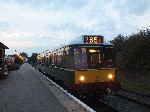 One of the highlights of the event was the Saturday Evening Fish & Chip special. This was run earlier than in previous years, starting at 17:00 from North Weald for ta trip to Ongar where chips were served at 17:30 followed by two round trips with several stops for people to depart if desired. It was noticed that this format worked really well and it was suspected that the earlier time allowed people with long journeys to stay for the special when in previous year's they wouldn't have. One to remember for future conventions perhaps? We were treated to fish or sausage and chips with a selection of ice cream for dessert as well! This was also new to us and also an excellent idea! With everyone in one place, it was a great social and a good time was had by all as the light dropped and the units ran into the dark. The Class 121 and 117/121 sets were coupled together for the run as is traditional, however we couldn't help but notice that the best heaters and a bar were in the bubble car, so strangely people seemed to congregate in there!
One of the highlights of the event was the Saturday Evening Fish & Chip special. This was run earlier than in previous years, starting at 17:00 from North Weald for ta trip to Ongar where chips were served at 17:30 followed by two round trips with several stops for people to depart if desired. It was noticed that this format worked really well and it was suspected that the earlier time allowed people with long journeys to stay for the special when in previous year's they wouldn't have. One to remember for future conventions perhaps? We were treated to fish or sausage and chips with a selection of ice cream for dessert as well! This was also new to us and also an excellent idea! With everyone in one place, it was a great social and a good time was had by all as the light dropped and the units ran into the dark. The Class 121 and 117/121 sets were coupled together for the run as is traditional, however we couldn't help but notice that the best heaters and a bar were in the bubble car, so strangely people seemed to congregate in there!
Sunday
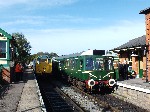 Sunday saw the weather revert to how it had been on Friday, giving those delegates who had made a weekend of it another burst of sunshine and warmth. The timetable and trains were broadly similar to that offered on Saturday, with the notable swapping of the steam locomotive with a Class 31 as no steam crew was available. Whilst the railway had advertised a steam service, most of our delegates were in fact pleased with the substitution, given our lean towards diesel traction, making the Brush Type 2 a bonus!
Sunday saw the weather revert to how it had been on Friday, giving those delegates who had made a weekend of it another burst of sunshine and warmth. The timetable and trains were broadly similar to that offered on Saturday, with the notable swapping of the steam locomotive with a Class 31 as no steam crew was available. Whilst the railway had advertised a steam service, most of our delegates were in fact pleased with the substitution, given our lean towards diesel traction, making the Brush Type 2 a bonus!
From lunchtime onwards and with long journeys home ahead, the remaining delegates dispersed signalling the end of a fantastic weekend. All that remains is to thank the Epping Ongar Railway for everything they laid on for us, organisation of the event, and particularly their hospitality in providing us with a meeting room in our hour of need. It really felt like we were very well catered for indeed. Links between the railway and groups were made and we hope to stay in contact with the line on matters regarding DMU's and other heritage railway issues.